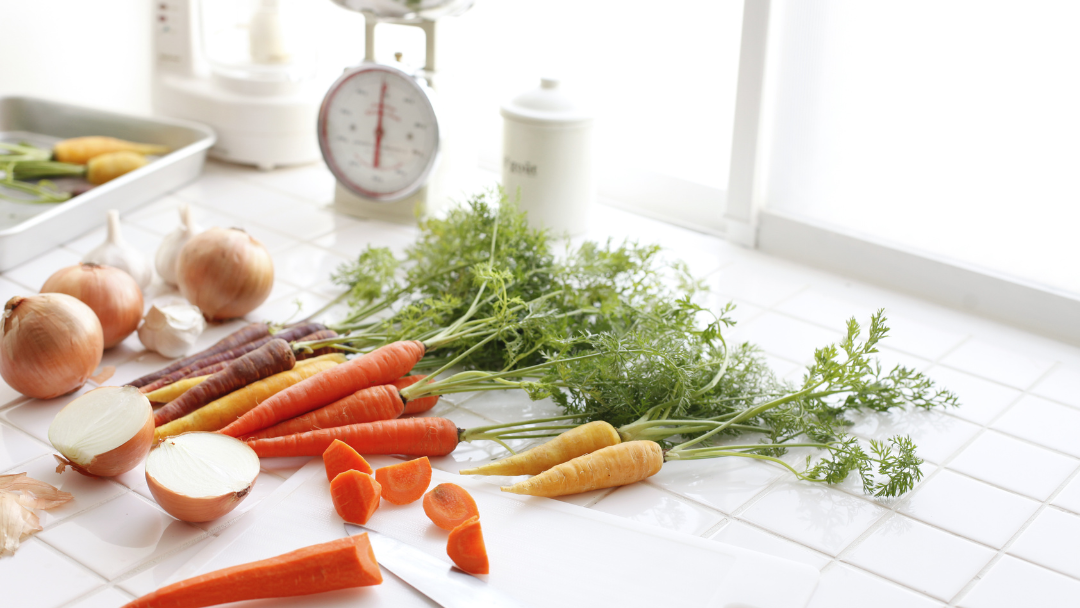Photo: kazoka/Shutterstock.com
Within nutrition and health trends, most emphasis pertains to which foods to eat or avoid. However, food preparation and storage can significantly impact health on either side of the spectrum, such as making food more nutritious or increasing exposure to toxic chemicals and inflammatory compounds. The good news is that most people will likely not change what they eat, but they may be open to changes in cooking or preparation that can profoundly affect their intake.
Increasing Nutrient Density of Foods
Organic Foods. Choosing organic foods when possible likely has health benefits. A systematic review found that organic foods contained more polyphenols, including phenolic acids, stilbenes, flavanols, and anthocyanins, than conventionally grown crops. Organic foods are also shown to have lower levels of heavy metals and pesticide residues. The safety of long-term pesticide consumption is controversial. However, both direct exposure (e.g., inhalation and dermal exposure by farm workers or via household use of pesticides) and indirect exposure (e.g., food and water) are associated with chronic diseases, such as cancer, diabetes, asthma, and cognitive impairment. Those who are especially vulnerable to pesticide exposure include pregnant women and children.

Figure 1. Routes of toxic exposures. Image Credit: Tudi M, Li H, Li H, Wang L, Lyu J, Yang L, Tong S, Yu QJ, Ruan HD, Atabila A, Phung DT, Sadler R, Connell D. Exposure Routes and Health Risks Associated with Pesticide Application. Toxics. 2022 Jun 19;10(6):335. doi: 10.3390/toxics10060335. PMID: 35736943; PMCID: PMC9231402. CC-BY 4.0: https://creativecommons.org/licenses/by/4.0/.
Seasonal Foods. Eating seasonally may have health benefits, too. One study investigating the vitamin C content of broccoli found that while vitamin C did not differ between conventionally or organically-grown broccoli, broccoli grown in the fall – when it’s in season – was almost twice as high as broccoli grown in the spring. Another study found seasonal variations of vitamin C and reported that the vitamin C content of spinach in winter samples was significantly higher than that of spring, summer, and fall. Additionally, including seasonal foods may encourage a person to eat a more diverse range of foods as their availability fluctuates throughout the year. However, restricting oneself to only seasonal foods can reduce food availability, especially if food is sourced locally in areas with short growing seasons.
Cruciferous Vegetable Preparation. Cruciferous vegetables may benefit from specific preparation methods to improve the bioavailability of plant compounds called glucosinolates, whose metabolites have several roles and health benefits. For example, the glucosinolate metabolite isothiocyanate may protect against cancers, improve blood sugar regulation in individuals with type 2 diabetes, and play a role in treating neurological and developmental conditions.
Upon cutting or chopping cruciferous vegetables, a plant enzyme known as myrosinase is released and helps break down glucosinolates into their bioactive metabolites. A number of factors affect the bioavailability of glucosinolates, including preparation methods and storage time. Buying the whole vegetable – versus a pre-chopped version – and allowing it to sit for 90 minutes (and perhaps as little as 40 minutes) after cutting can increase myrosinase activity and improve the bioavailability of glucosinolates. Further, the availability of isothiocyanates can be strongly impacted by cooking, as myrosinase is sensitive to high temperatures and prolonged cooking time. Lightly cooking cruciferous vegetables by stir-frying, steaming, and microwaving can increase isothiocyanate content, while heavily cooking by boiling and stewing can decrease isothiocyanate content. Consuming cruciferous vegetables with mustard seed powder may increase myrosinase activity and the release of isothiocyanates.
Takeaway: When possible, choosing in season foods may increase nutrient density, encourage food diversity, and motivate oneself to consume more fruits and vegetables. Allow cruciferous vegetables to sit for a minimum of 40 minutes after chopping, lightly cook them, and add mustard seed powder to increase the bioavailability of health-promoting plant compounds.
Fresh/Frozen/Canned/Dehydrated Foods
Fresh vs. Frozen Food. Contrary to popular belief, fresh fruits and vegetables are not necessarily more nutritious than frozen. A study assessed vitamin C, vitamin A, and folate concentrations in seven fruits and vegetables that were fresh, frozen, and “fresh-stored,” meaning the foods were refrigerated for five days. The results showed no significant differences in nutrient concentrations between storage methods, although “fresh-stored” items tended to have a negative association with nutrient concentration compared to other storage methods. This finding may imply that locally-bought foods that have not been transported long distances could be more nutritious.
Canning. Canned food is convenient and affordable; however, its consumption is associated with increased urinary levels of bisphenol-A (BPA), a food packaging chemical with endocrine-disrupting properties shown to leach into food products. According to NHANES data, higher BPA concentrations were associated with canned fruits, vegetables, pasta, and soup, but not canned beverages. A randomized intervention explored the effect of canned food consumption on BPA concentration in urine. Results showed that BPA concentrations were significantly higher in the canned food group compared to the fresh foods group, particularly in the first 6 hours after intake. BPA concentrations returned to baseline after 24 hours following ingestion.
Several factors can influence the migration of BPA into food, including acidic and basic (vs. neutral) conditions, high levels of sodium chloride, and the presence of vegetable oils. BPA can also accumulate in cans during storage. It may be best to minimize the use of canned foods, but if canned foods must be used, choose those that are sodium free and packed in water. For acidic foods, such as tomato sauce, opt for products in glass jars. When preparing frozen vegetables in the microwave, transferring them to a glass container prior to cooking is best to avoid the migration of chemicals from food packaging as heat increases BPA leaching.

Figure 2. Harmful effects of bisphenol A. Image Credit: Cimmino I, Fiory F, Perruolo G, Miele C, Beguinot F, Formisano P, Oriente F. Potential Mechanisms of Bisphenol A (BPA) Contributing to Human Disease. Int J Mol Sci. 2020 Aug 11;21(16):5761. doi: 10.3390/ijms21165761. PMID: 32796699; PMCID: PMC7460848. CC-BY 4.0: https://creativecommons.org/licenses/by/4.0/.
Dehydration. Dehydrated fruits and vegetables improve preservation, convenience, and availability of out-of-season produce. Researchers explored the effects of dehydration on vitamin C, thiamine, and beta-carotene in green leafy vegetables. They found that vitamin C and beta-carotene exhibited significant reductions after dehydration, while thiamine exhibited some losses but was overall better retained. A more recent study investigated the effects of air drying (i.e., use of hot air), freeze drying, and radiant energy vacuum (REV) dehydration (low-heat drying) on the nutritional values of broccoli, oranges, and carrots. Results showed that compared to air drying, freeze-drying, and REV dehydration retained higher levels of vitamin C and beta-carotene.
Takeaway: Frozen produce can be just as nutritious as fresh, offering affordable and convenient ways to eat more fruits and vegetables. Choose freeze-dried over conventionally dried fruits and vegetables to increase nutrient density. Avoid canned products when possible and remove frozen produce from bags before microwaving to reduce exposure to toxins.
Cooking Methods
Each cooking method has advantages and disadvantages to consider; therefore, no one cooking method is necessarily “best.” Cooking methods may improve the availability of some nutrients while compromising others. Cooking also decreases the starch content of vegetables, such as sweet potatoes, while increasing the sugar content, which makes vegetables taste sweeter and more palatable. As discussed in a previous blog, cookware can contribute to the body’s toxic burden. The following section reviews the advantages and disadvantages of common cooking methods.
Raw. Consuming foods in their raw and natural state preserves nutrients, such as thiamine, pantothenic acid, and vitamin C, which are sensitive to heat. Water-soluble vitamins may be lost in cooking water and are, therefore, better preserved in raw foods. Raw foods also maintain the original plant microbiome, especially when grown organically. The plant microbiome may positively impact the human gut microbiome. Locally-grown foods may also maintain the original plant microbiome as they may not be sterilized for transport and distribution. On the other hand, some individuals may find raw foods challenging to chew and digest. Raw foods may have decreased availability of fat-soluble nutrients, which may benefit from heat by allowing for greater nutrient extraction from plants. Raw foods may also contain harmful microorganisms, such as E. coli and Salmonella, if not properly handled.

Figure 3. The connection of soil, plant, and human through biomes. Image Credit: Blum WEH, Zechmeister-Boltenstern S, Keiblinger KM. Does Soil Contribute to the Human Gut Microbiome? Microorganisms. 2019 Aug 23;7(9):287. doi: 10.3390/microorganisms7090287. PMID: 31450753; PMCID: PMC6780873. CC-BY 4.0: https://creativecommons.org/licenses/by/4.0/.
Steaming. Steaming entails minimal heat and water for varying amounts of time. Unlike raw foods, steaming foods can result in a softer texture that’s easier to digest. It also results in a brighter color, increases the bioavailability of fat-soluble nutrients, and reduces goitrogens, a class of “antinutrients” found in cruciferous vegetables that may interfere with thyroid function. Steaming foods may better retain nutrients and phytochemicals in vegetables compared to boiling. Foods, such as broccoli, should be steamed until the color is bright but the texture is still crunchy.
A combination of steaming and microwaving may result in the best antioxidant availability, as reported in a recent study that assessed the effects of different cooking methods (steaming, boiling, and microwaving) on the nutritional profiles of cauliflower, sweet potatoes, and carrots. Another study found similar results when assessing the effects of cooking methods on purple sweet potatoes. Results showed that a combination of microwave cooking and steaming retained more phytochemicals and increased antioxidant capacity than those that had been either microwaved or steamed.
Pressure cooking uses steam under pressure to quickly cook food. As seen in a study on the antioxidant activity of bananas, pressure cooking may improve the phenolic, tannin, and flavonoid content. Another study showed that pressure cooking retained more vitamin C and sulforaphane in broccoli compared to boiling and steaming.
Boiling. Boiling exposes vegetables to heat and water for several minutes and sometimes hours. Similarly to steaming, this method of cooking makes the texture of foods soft, thus easier to digest, and increases the bioavailability of fat-soluble nutrients. Boiling may also reduce “antinutrients,” including oxalates, goitrogens, lectins, and phytates, as well as histamines (by diluting them).Boiling may cause significant losses of water-soluble nutrients, such as vitamin C, as they leach into cooking water.
Dry heat. Dry heat cooking methods include grilling, frying, air frying, broiling, baking, and roasting. The advantages of dry heat cooking are primarily personal preference. Cooking methods, such as grilling and baking, connect to sensory cues and have associations with social events, such as holidays and barbeques. Dry-heat cooking methods, such as roasting and air frying, can also save time, and make vegetables crisp. Despite these advantages, dry heat cooking methods reduce heat-sensitive vitamins and increase histamines, lectins, and oxalates. Dry-heat cooking methods also contribute to forming inflammatory compounds known as advanced glycation end products (AGEs). AGEs give browned food, such as grilled meat, its distinctive flavor. These compounds naturally form during metabolism, but the diet can contribute to excessively high amounts of AGEs in the body, which become problematic and are associated with the development and progression of chronic diseases, including type 2 diabetes, cardiovascular disease, and chronic kidney disease. AGEs appear to increase initially and then decrease as baking time progresses. Therefore, baking for longer periods of time vs. quick roasts, as well as using lower temperatures, may be preferable. However, unlike AGEs, other heat-induced toxicants, such as 5-hydroxymethylfurfural (HMF), continue to increase exponentially under heat.
Aluminum foil is commonly used when baking, roasting, and grilling as it improves clean up time. However, its use poses some concerns as it is shown to migrate into food during cooking and, in some instances, completely disintegrate under extreme temperatures, acidic conditions, and prolonged contact time. One study found that one week of daily consumption of fish patties in a lemon (acidic) marinade cooked using aluminum camping utensils may exceed the Tolerable Weekly Intake for adults and children by 187% and 871%, respectively. A more recent study showed that aluminum migrated into beef, chicken, and fish when simply wrapped in aluminum foil, and even more so when chicken and fish were seasoned with salt, pepper, and lemon. Aluminum is a known neurotoxin, so it’s best to avoid using aluminum foil and aluminum baking dishes, especially if using acidic marinades.
Parchment paper is another popular option and is essentially paper coated with silicone to reduce sticking and improve clean up time. Research on silicone exposure via food is less available than other cookware. Available research suggests that some silicone does migrate into food, though it is below the overall migration limit of 60 mg/kg and dependent on fat content. Therefore, parchment paper is likely safer to use compared to aluminum, especially if minimizing the amount of fat used.
Microwaving. Microwave cooking may not lead to significant nutrient losses due to short cooking durations and minimal water use. In one study, microwaving spinach, carrots, sweet potatoes, and broccoli was shown to have high vitamin C retention compared to boiling, steaming, and blanching. Though research is conflicting, microwaving food may produce acrylamides, sometimes at higher levels than conventional roasting. Acrylamides contribute to AGE formation and may lead to DNA mutations. If microwaving, it may be best to use lower power settings, microwave for shorter amounts of time, and use salt and antioxidant-rich spices, such as black cumin, which may reduce acrylamide formation.
As you can see, each cooking method has potential drawbacks and benefits. Additionally, nutrient losses by cooking can vary by food. For example, researchers found that microwave cooking of crown daisy (an edible flower) and mallow caused significant vitamin K loss, but microwave cooking of spinach and chard caused the least loss of vitamin K. Therefore, including a variety of cooking methods may be best. If using gas appliances, it’s essential to use a venting range hood to reduce the adverse effects on indoor air quality. Finally, preferred cookware that reduces toxic burden includes ceramic, glass, stainless steel, and cast iron. For more information on cookware, you can read my blog about reducing the toxic burden from cookware.
Takeaway: Use a variety of cooking methods to obtain a variety of nutrients; however, dry heat is least desirable. Slow, low, moist heat is preferred.
Storing Cooked Foods
Leftovers can be a convenient way to consume more plant foods with less time spent on daily food preparation. However, it’s important to consider how the food is stored, and the impact storage can have on its nutritional value.
Food Storage Containers. The best storage container for cooked food is glass; plastic should be avoided. Similarly to its use in canned foods, bisphenol A (BPA) is used in plastic food storage containers and is associated with many adverse effects, including obesity, type 2 diabetes, altered liver function, and learning impairments. “BPA-free” plastic containers should also be avoided because BPA analogs, such as bisphenol S (BPS), have been shown to leach into food and are as toxic, if not more toxic, than BPA. If plastic must be used, avoid microwaving food in plastic food containers.
Nutrients and Storage. Nutrients may degrade over time. A study on dehydrated garlic, onions, potatoes, and carrots assessed thiamin and vitamin C content during storage over 12 months, during which they were protected from heat and light. Vegetables retained thiamine well over the first three months, but levels continued to decline over 12 months. Vitamin C was sensitive to storage, and in dehydrated onion, no vitamin C was detected after 12 months. As previously mentioned, a study found that foods that were refrigerated for five days (vs. being fresh or frozen), tended to have a negative association with nutrient concentration compared to fresh or frozen foods. Additionally, mineral bio-accessibility in beans appears to decrease over time. This implies that one may wish to minimize food storage and consume more fresh foods when available.
Histamines. Storing protein-containing leftovers can increase the histamine content of meals. However, freezing foods can prevent or slow histamine production. Individuals who are histamine intolerant or those suffering from seasonal allergies may benefit from reducing histamine formation in food.
Takeaway: Store leftovers in glass containers and avoid microwaving plastic containers. If sensitive to histamines, fresher foods (or fresh foods that are frozen) will contain lesser amounts of histamines compared to foods stored in the refrigerator.
If you plan to make changes to your daily eating, cooking, or food storage methods, or have food allergies or questions about which foods can best support your health goals, talk to your doctor, nutritionist, dietician, or another member of your healthcare team for personal options based on your circumstances.





